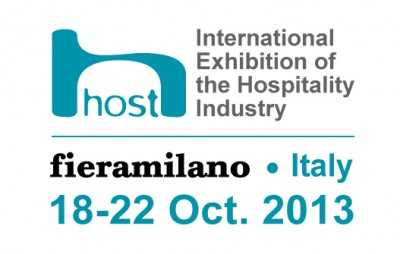MILAN, Italy –The global capital of the HO.RE.CA. sector and undisputed setter of international lifestyle trends, a platform for trailblazing concepts and layouts, and a showcase for tomorrow’s icons today.
Host 2013, the international professional hospitality show which ends today at the Milan Fairgrounds Rho, offers all this and more .
The event is also a major catalyst driving the growth of other sectors of the Italian economy and bringing together stakeholders keen to understand where the industry is currently at.
As always, Host 2013 sets the ideal backdrop for defining growth strategies, leveraging its unparalleled role as a unique observation post on developments in the Ho.Re.Ca. and Retail sector thanks to the unrelenting efforts of the Host team during the two-year interval between shows.
Horizon 2020:+5%
Italian catering and hospitality equipment suppliers are significantly enhancing their efficiency to counter the enduring sluggishness of the global economy, where domestic demand across Europe is still disappointingly low.
This is the conclusion of the third industry balance sheet analysis study undertaken for Host 2013 by Confindustria Ceced Italia – the Italian association of domestic and professional equipment manufacturers.
The 2012 analysis, which examines economic and financial trends among more than 350 enterprises in 14 product areas, reports that operating margins across the sector are up di +0.7 percentage points, marking a slight improvement over 2011 (-0.5), whilst total revenues are still down around two percentage points.
More specifically, the gross value of production, withyear 2000 as base=100, puts 2012 at above130, while EBITDA (i.e. gross operating margin) has increased from 2009’s all-time low of 9.5% to around 11.5%.
According to the Association’s forecasts, companies will have to endure the current crisis until 2015, when a turnaround is expected to generate growth of +5% by 2020 in commercial catering.
Innovation as a driver of growth goes hand in hand with sustainability:according to Ceced’s Future of Foodservice and Energy Consumption research:between now and 2020 the adoption of sustainable solutions will slash energy consumption levels by at least -20%, leading to obvious benefits along the entire supply chain.
The catering industry picks up
CNA– the Italian association of SMEs and small businesses – report that retail food establishments seem to have weathered the global financial crisis quite well.
According to research by the Milan Chamber of Commerce using data from the Registry of Businesses, between Q2 2013 and Q2 2013, the sector has grown +1.7% country-wide:the biggest upswings were reported by Sicily (+3.5%), Campania (+2.8%) and the Lazio region (+2.4%).
There are around 315,000 food service businesses in Italy.More than half (53.1%) are restaurants, while 46.9% are bars, coffee shops or other establishments without kitchens.Lombardy heads the list, with almost 50,000 businesses (15.4% of the total), including 22,000 restaurants and 26,000 bars and cafés.Next come Lazio (10.6%) and Campania (9.2%).
As far as Italian cities go, Rome ranks first in terms of the number of businesses (24,710), followed by Milan with 15,911 and Naples with 14,163. Palermo is the city with the fastest growth rate (+6.5%).
Export-driven Italian excellence
Many segments of the Ho.Re.Ca. and Retail sector are admired the world over as examples of Italian excellence, and exports are undeniably a factor in the sector’s staying power and growth, according to data released by ANIMA – the Federation of the Italian Associations of Mechanical and Engineering Industries, which is also a member of Confindustria, the Italian Employers’ Federation.
In particular, this year the bread, biscuit, pastries and pizza machinery and ovens sector will post the same production value as 2012, i.e. 645 million euros, while exports, accounting for more than half of the market (63%) are expected to grow by +0.7%, from 405 to 408 million euros.
The trade balance is positive, and virtually stable, at 491.59 million euros.
Imports by two Mediterranean countries in 2012 deserve particular mention:Turkey (31.35 million euros, +189%) and Algeria (10.80 million euros, +131%).Other emerging countries have also posted encouraging import figures, such as Romania (17.41 million euros, +58%) andMexico (12.75 million euros, +48%).
Between 2008 and 2012, the breakdown of exports by geographical areas has witnessed a decline in exports to the 27 EU countries (down from 47.4 to 36.1%) offset by increased flows to non-EU countries, especially in Asia (up from 13.7 to 17.8%).The ratio of exports to imports in 2012 was slightly down compared to 2008, but still above 110%.










